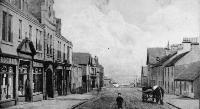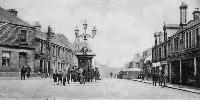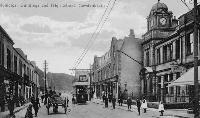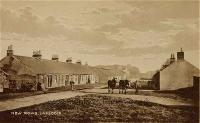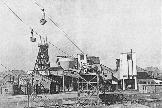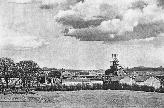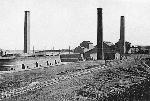Ordnance Gazetteer of Scotland, Francis H Groome, 1885
Cowdenbeath, a village in the S of Beath parish, Fife, 2 miles WSW of Lochgelly, and 3 furlongs N by W of Cowdenbeath Station on the Edinburgh, Perth and Dundee section of the North British, this being 5 1/4 miles ENE of Dunfermline. It has a post office under Lochgelly, with money order, savings bank, and telegraph departments, a Free Church, and a public school; and in the neighbourhood are the extensive collieries of the Cowdenbeath Coal Co. Pop. (1861) 1148, (1871) 1457, (1881) 2712.
Kelty, a collier village in Beath Parish, Fife and Cleish Parish, Kinross-shire, 7 furlongs W of Kelty station on the Kinross-shire section of the North British railway, this being 5 miles SSE of Kinross. It has a free church and a public school. Pop. (1871) 792, (1881) 860, of whom 752 were in Beath
Hill of Beath, mining village in Beath parish, Fife, 1/2 mile NW of Crossgates station, and 3 3/4 miles ENE of Dunfermline. Pop. (1871) 315, (1881) 352.
Lassodie, a collier village in Beath parish, Fife, 4 1/2 miles NNE of the post town Dunfermline. It has a post office, public school (1877), and a Free church. Lassodie House is the seat of James Dewar, Esq. (b 1849), who holds 1047 acres in the shire, valued at £2087 per annum. Pop. of village (l881) 808 – Ord. Sur. sh.40, 1867.
A topographical dictionary of Scotland, Samuel Lewis, 1846
Cowden-Beath, a village, in the parish of Beath, district of Dunfermline, county of Fife, 1/2 a mile (SE) from Beath; containing 127 inhabitants. It is in the south-eastern part of the parish, a short distance west of the road from Aberdour to Kinross.
Kelty, a village, in the parish of Beath, district of Dunfermline, county of Fife, 6 miles (NE by E) from Dunfermline; containing 257 inhabitants. The population consists chiefly of colliers employed in the mines of the parish. There is a place of worship here for members of the Free Church.
Kelty, a village, in the parish of Cleish, county of Kinross, 5 miles (S by W) from Kinross ; containing 164 inhabitants. It is situated in the south-eastern part of the parish, and a short distance west of the road from Burntisland to Kinross. In the vicinity is Blair-Adam inn, where is a post-office.
Oakfield, a village, in the parish of Beath, district of Dunfermline, county of Fife; containing 102 inhabitants. It is one of two small villages in the parish, the other, the more considerable, being Kelty ; and is chiefly inhabited by colliers.
Beath, a parish, in the district of Dunfermline, county of Fife, 2 1/2 miles (S) from Blair-Adam Inn ; containing, with the villages of Cowden-Beath, Kelty, and Oakfield, 973 inhabitants. This parish, though now destitute of any trees of the kind, is supposed to have originally abounded with birch, and from that circumstance to have derived its name, anciently written Baith, which, in the Gaelic language, signifies a birch-tree. It is situated on the great road from Perth to Queensferry, extending for about four miles in length, and three miles in breadth, and comprising 6500 acres, of which about 5300 are arable, 500 meadow and pasture, 500 woodland and plantations, and the remainder water and waste. The surface is very irregular, rising in many places into hills of considerable elevation, some of which afford rich pasture, and one called the Hill of Beath commands interesting views; the scenery has been, in some parts, enriched with thriving plantations, and is enlivened by the loch Fitty, a fine sheet of water, about three miles in circumference, and abounding with pike, perch, and other fish. The soil is generally good, consisting of a clay and loam, interspersed occasionally with moss; the crops are oats, barley, peas, beans, potatoes, and turnips, with wheat occasionally, and a small quantity of flax. The system of agriculture is excellent; a considerable quantity of waste has been reclaimed, and much which, from previous mismanagement, had been unproductive, has been rendered fertile. The rateable annual value of the parish is £4404. The substrata are chiefly whinstone and sandstone; coal is found in abundance, and there are at present three collieries worked in the parish, which afford a plentiful supply of fuel; limestone is also wrought, but on a very limited scale. The parish is in the presbytery of Dunfermline and synod of Fife, and in the patronage of the Earl of Moray; the minister’s stipend is about £165, with a manse, and a glebe valued at £17 per annum. The church is a handsome edifice, erected in 1835, by the heritors, and affords ample accommodation. The parochial school is attended by about 100 pupils; the master has a salary of £34 4s 4d, with £30 fees, and a house and garden.
